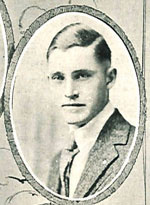In 1919, all undergraduates at the University of Iowa were required to take a drawing class. Were it not for that requirement, it’s possible that some of Europe’s greatest artistic treasures would have been destroyed by the Nazis during World War II.
That’s because one of those students who took the drawing class would be so inspired by art that he took up a career in the field, and 20-some years later helped to form a military unit that saved countless masterpieces from destruction.

His unit—formally known as the Monuments, Fine Arts and Archives Section—is the subject of The Monuments Men, a new movie opening Feb. 7. Star George Clooney plays Frank Stokes, a character based on George Stout, who graduated from the UI in 1921 and went on to become one of the leading figures of 20th century art.
“He’s a legend in the field of art conservation, which is the quiet part of museum work,” says Sean O’Harrow, director of the UI Museum of Art. Stout was born in Winterset in 1897 and attended Grinnell College for two years before joining the military during World War I. He enrolled at UI in 1919 after the war and studied art and English for two years.
Although he’d always loved art and had a great appreciation for it before coming to UI, Stout had no formal art training until he took that required drawing course.
“I started to draw, as many boys did because they liked to make an image of something that was roughly recognizable. I started that when I was very young and kept on with it,” Stout said in a 1978 oral history interview with the Smithsonian Institute’s Archives of American Art. “(A friend) said, ‘Why don't we go to the University of Iowa? They've got an art department there and it would be a chance for us to do what we enjoy doing and learn something more about it.’ So we did.”
He was active in writing as an undergraduate, too, as a staff member of The Daily Iowan, the Frivol humor magazine, and The Hawkeye yearbook. He was also a member of Sigma Delta Chi, the journalism professional society, but whatever career as a newsman he may have considered was set aside for the love of art that was nurtured in his drawing class.
“After graduation, in 1921, I was offered a job as an instructor in drawing and along about that same time my wife was offered a similar job, so we taught drawing and did some graduate study, mainly in the practice of the arts—drawing and painting,” Stout said in his Smithsonian oral history.
He spent three years on the faculty, marrying Margaret Hayes (her father, Samuel, was on the university’s law faculty) and they “saved up what pennies we could put together” to leave for Paris in 1924 for two years of formal instruction in art. O’Harrow wonders if he didn’t cross paths while he was there with Grant Wood, who was by the early 1920s well known in the Cedar Rapids/Iowa City art community and who was in Paris himself in 1923 and 1925, before returning home to paint “American Gothic” and, in 1932, join the UI art faculty.
Jackson and George
Thanks to the work of people like George Stout, the pride of the University of Iowa art collection is getting spruced up.
Sean O’Harrow, director of the UI Museum of Art, says much of that treatment is because of the scientific study and experimentation done by Stout and other developers of the conservation field.
Mural, the iconic piece painted by American abstract expressionist Jackson Pollock in 1943, is undergoing technical study and conservation treatment by research scientists at the Getty Conservation Institute and conservators at the J. Paul Getty Museum in Los Angeles.
Mural, is seen by many as symbolizing the beginning of the American revolution in abstract art after World War II. It was donated to the university in 1951 by Peggy Guggenheim, who commissioned it. Like the rest of the Museum of Art’s collection, it was removed from campus when the art museum was flooded by the Iowa River in 2008.
The piece will return to Iowa for an exhibit at the Sioux City Art Center from June 10, 2014 to April 10, 2015.
Stout left Paris in 1926 to earn a Master’s degree at Harvard University and then become a conservator at the university’s Fogg Art Museum. But O’Harrow points out that he didn’t just become a conservator—he was one of the pioneers in the field by concluding that it was better to preserve art than to repair it. He conducted scientific experiments to determine how different types of paint react to light, say, or how quickly a canvas dried in air of various humidities, and developed scientific protocols to minimize decay.
“He realized it was easier to preserve what was there and attempt to address the degradation, and he performed long, laborious experiments to see how materials degraded and how that can be arrested,” O’Harrow says. “It’s a shockingly difficult and complicated field. You have to be trained in organic chemistry, for example; that’s how difficult it is to get into.”
But preservation is not why Hollywood made a movie about George Stout, especially one starring A-list stars like Clooney, Bill Murray, Matt Damon, John Goodman, Hugh Bonneville, and Cate Blanchett. What drew Hollywood’s attention is the unit he helped put together in 1943 to move across Europe with Allied armies and save thousands of priceless pieces of art that were in harms way, or had been pilfered by the Nazis and stashed away in caves, mines, castles, and other hidden locations.
“It’s a central piece of human history, that when you go to war you bring back a lot of good stuff,” says Richard Koontz, an instructor in the College of Law who teaches a class on cultural property and the law. In this case, Koontz says Hitler wanted to accumulate as much great art as he could because of his belief that, as the Aryans are the master race, they should also possess the world’s greatest works of art.
The Monuments, Fine Arts and Archives Section was created at first with just a few dozen people (although it would grow to 400), mostly museum directors, art historians, curators, conservationists, and other personnel. They worked with Allied armies to protect vital cultural objects in combat, and find and protect art that was looted by Nazis or hidden by museums behind Nazi lines to protect them from battle.
More than 1,500 of these repositories were eventually found—one of them, in a salt mine, held more than 40 tons of art—and thousands of works by such masters as Vermeer, van Eyck, Rubens, Goya, and Botticelli were saved.
Koontz says the work of Stout and the others helped lead to a broader conversation about how to protect cultural treasures during wartime. He says it was especially important in light of the fact that much of the art the Nazis stole had belonged to Jews who fled Germany or were sent to concentration camps, giving the issue a human rights angle.
“They asked, how do you protect in a war the art that most defines a culture and a country’s history?” he says. An immediate result of these discussions Stout helped to start was the 1954 Convention of The Hague for Protection of Cultural Property in the event of Armed Conflict, which requires signatories to protect to the best of their ability important cultural and artistic sites of their enemies during a war.
After the war, Stout moved onto Japan where he helped to preserve great works of art and other cultural artifacts there that were threatened in the Pacific theater. Later, he continued to create his own art, but his greatest contribution came as director of the world-renowned Isabella Stewart Gardner Museum in Boston. He also founded and was the first president of the International Institute for Conservation.
But O’Harrow says few people knew of his wartime exploits, as he rarely discussed his work with the Monuments Men.
“He was a down to earth Iowan who didn’t like to brag,” O’Harrow says.
Stout returned to Iowa City only occasionally after graduating, visiting his mother-in-law as documented in various issues of the Iowa City Press-Citizen. He died in Santa Clara, Calif. in 1978.
